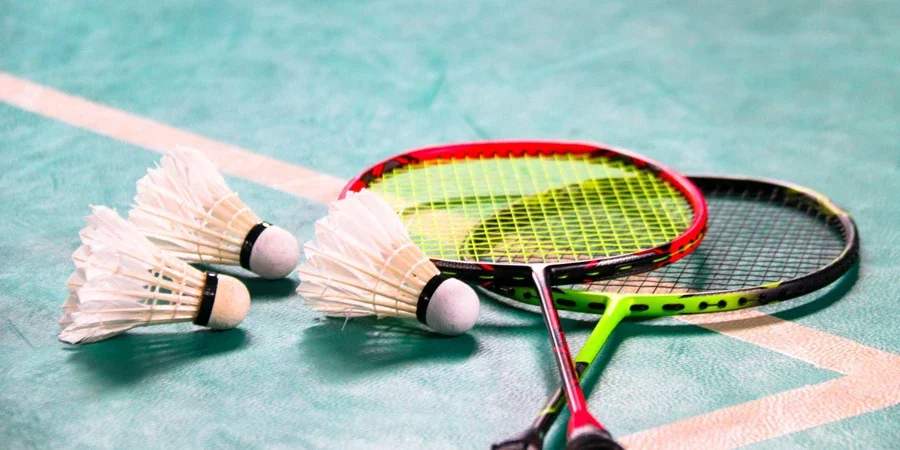A badminton racket is not just a piece of sports equipment it’s an extension of the player’s hand, a fusion of engineering and artistry that defines the pace, power, and strategy of the game. Understanding a badminton racket and its evolving elements is key to understanding the sport itself. From material innovations to ergonomic grip designs, today’s rackets reflect a fascinating blend of physics, craftsmanship, and personal preference. In the first glance, a badminton racket and its string pattern may seem simple a netted oval frame atop a thin shaft. But within that simplicity lies an entire world of nuanced choices: weight balance, flexibility, tension, aerodynamics, and materials. For professionals and enthusiasts alike, knowing how each of these factors interacts can make the difference between a winning smash and a weak return. This article explores everything about badminton racket and its design principles, material evolution, cultural relevance, and the psychological connection players share with their chosen weapon of play.
Overview of Badminton Racket and Its Key Characteristics
| Component | Description | Material | Impact on Play | Ideal for |
|---|---|---|---|---|
| Frame | The main oval head of the racket | Graphite, carbon fiber, aluminum | Determines power and control | All players |
| Shaft | The connecting rod between handle and head | Carbon composite | Affects flexibility and speed | Intermediate/Advanced |
| Grip | Handle wrapped for comfort and control | PU, towel, synthetic | Influences stability and comfort | All levels |
| Strings | Netbed used for striking the shuttle | Nylon, multifilament | Controls tension and repulsion | Advanced players |
| Balance Point | Distribution of weight | Head-heavy, head-light, even | Alters power vs. speed | Offensive/defensive styles |
| Flexibility | Shaft’s bending capacity | Stiff or flexible | Adjusts accuracy and feel | Player-dependent |
The Evolution of the Badminton Racket
The earliest badminton rackets, dating back to 19th-century England, were made from wood, heavy and rigid, reflecting the slower pace of the early game. As the sport evolved especially with the introduction of carbon fiber and aluminum in the 20th century the racket transformed into a tool of agility and speed. Modern rackets weigh between 70–95 grams, offering a near-weightless feel while delivering enormous shuttle velocity. Manufacturers now use nanomaterials, carbon nanotubes, and hybrid resins to create frames that resist deformation at high swing speeds. This transformation mirrors badminton’s own journey from a parlor pastime to an Olympic sport known for its blistering rallies and intense physical demand.
Understanding the Anatomy of a Badminton Racket
To appreciate the engineering behind a racket, let’s explore its key components in detail.
1. Frame
The frame forms the striking area of the racket. It must be both lightweight and rigid to maintain accuracy. Today’s aerodynamic frames feature isometric (square-shaped) heads, which expand the “sweet spot,” allowing even off-center shots to carry power.
2. Shaft
The shaft is the backbone that transmits energy from the wrist to the shuttle. Its flexibility determines shot response. A stiff shaft favors fast, strong players who can generate wrist power; a flexible shaft benefits beginners and defensive players by adding repulsion to slower swings.
3. Grip
A seemingly small detail, grip size and material dramatically affect control. Synthetic grips offer tackiness, towel grips absorb sweat, and layered grips balance comfort and precision. Proper grip selection prevents slippage, ensuring confidence in every stroke.
4. Strings
Strings are the “heart” of the racket. Their tension measured in pounds (lbs) affects how much the shuttle rebounds upon impact. Lower tension (18–22 lbs) gives more power and forgiveness; higher tension (24–30 lbs) provides control and sharper response for skilled players.
5. Balance Point
Balance defines how the racket feels in motion. A head-heavy racket delivers powerful smashes but tires the arm faster. A head-light racket enhances agility for quick defense. An even balance model offers all-round versatility.
Technological Advancements in Modern Racket Design
The past two decades have seen an explosion of innovation in racket technology. Manufacturers now employ advanced materials and structural reinforcements to improve speed, durability, and precision.
Carbon Nanotube Infusion
This technology strengthens the racket’s molecular structure, offering improved resilience without adding weight. It allows sharper smashes and faster recovery.
Isometric Head Shapes
Pioneered by brands like Yonex, isometric frames expand the sweet spot by about 30%, improving shot consistency.
Aero-Box Frame Design
This hybrid aerodynamic structure minimizes air resistance, enabling faster swing speeds a crucial factor in professional play.
Built-in T-Joints
These joints stabilize the connection between shaft and frame, preventing distortion during impact.
Rotational Generator Systems
By redistributing weight across the handle, frame, and head, these systems create natural balance, enhancing control and reducing fatigue.
How to Choose the Right Badminton Racket
Selecting the right racket involves balancing personal comfort with playstyle. The perfect racket for one player might feel awkward for another.
Key Factors to Consider
- Player Level: Beginners benefit from lightweight, flexible rackets; advanced players prefer stiffer shafts for precision.
- Playing Style: Aggressive players choose head-heavy rackets; defensive players prefer head-light models.
- Grip Size: Smaller grips enhance wrist movement, while larger ones add stability.
- String Tension: Low for power, high for control.
- Material: Graphite and carbon fiber remain the standard for durability and performance.
Example Table: Choosing by Style
| Playing Style | Recommended Balance | Flexibility | String Tension | Ideal Weight |
|---|---|---|---|---|
| Power (Smash) | Head-heavy | Stiff | 26–30 lbs | 85–95g |
| Control/Defense | Head-light | Flexible | 20–24 lbs | 75–85g |
| All-round | Even | Medium | 22–26 lbs | 80–88g |
The Science of Power and Control
The physics of badminton rackets involves delicate trade-offs. When a player swings, energy transfers from the wrist to the shuttle through the shaft and strings. A stiffer shaft transmits this energy more directly, while a flexible one absorbs some energy before releasing it a “catapult effect.” Power depends on the mass behind the shuttle and the velocity of the swing. Control, on the other hand, comes from minimizing vibration and maximizing frame stability. Racket makers today fine-tune these dynamics using computational simulations and wind tunnel testing, turning each new model into a micro-engineering marvel.
Badminton Racket Materials: A Timeline of Innovation
| Era | Common Material | Advantages | Drawbacks |
|---|---|---|---|
| 1800s | Solid wood | Durable, traditional | Heavy, inflexible |
| 1950s | Steel | Strong, affordable | Rusts, heavy |
| 1970s | Aluminum | Lightweight | Lacks stiffness |
| 1980s | Graphite | Lightweight, strong | Costly |
| 2000s | Carbon Fiber | Durable, aerodynamic | Expensive |
| 2020s | Nanocarbon + Resin | Ultra-light, high precision | Premium price range |
Modern carbon composites not only reduce weight but also improve torsional stability the ability to resist twisting during impact, ensuring consistent shots even under intense play.
The Role of Grip and Feel
Players often describe the “feel” of a racket in personal terms responsive, soft, stiff, or explosive. This feel depends largely on grip customization. Over-grips, under-wraps, and even handle taping patterns influence feedback during shots. Some professionals use towel grips to absorb sweat during long matches, while others prefer polyurethane for tackiness. A perfectly adjusted grip creates harmony between hand and racket a psychological edge that translates into confidence on the court.
The Cultural Symbolism of the Badminton Racket
Beyond sport, the badminton racket symbolizes discipline, agility, and adaptability. In Asian countries like Indonesia, Malaysia, and China, owning a racket often represents aspiration a bridge from local playgrounds to international arenas. Brands sponsor national heroes, turning specific models into icons. For instance, the same way tennis has its signature racquets, badminton rackets become cultural artifacts linked to star players and national pride. This intersection of sport, identity, and industry has transformed the badminton racket into more than a tool it’s a symbol of modern athletic craftsmanship.
Badminton Racket Maintenance and Lifespan
Even the best rackets need care to sustain performance. Strings lose tension over time; grips wear down; and environmental changes affect the frame.
Maintenance Tips:
- Store in a temperature-controlled environment.
- Restring every 3–6 months depending on usage.
- Avoid prolonged exposure to moisture or heat.
- Replace grips regularly for hygiene and comfort.
Expected Lifespan:
A professional-grade racket can last 1–3 years under heavy use, while casual players may keep one for 5+ years with proper care.
The Psychological Connection Between Player and Racket
Every badminton player develops a unique relationship with their racket a subtle bond of trust. It’s not unusual for professionals to use the same model for years, adjusting only minor specifications. This connection goes beyond mechanics. It involves muscle memory, rhythm, and confidence. The racket becomes part of the athlete’s identity, responding to every flick of emotion as much as motion.
Environmental Sustainability and Future Directions
The next generation of badminton rackets is not just about performance it’s about sustainability. Manufacturers are experimenting with bio-resins, recyclable composites, and carbon-neutral production methods. The challenge lies in maintaining strength while reducing ecological footprint. Eco-friendly models are emerging as symbols of ethical innovation in sports. We might soon see rackets made from plant-based polymers or designed for circular recycling a revolution that blends athleticism with environmental awareness.
Economic Impact of the Badminton Racket Industry
The global badminton equipment market is valued in billions, with rackets at its core. From manufacturing hubs in Japan, Taiwan, and China to retail distribution in Europe and the Americas, the badminton racket fuels a vast supply chain of design, marketing, and culture. Professional sponsorships, international tournaments, and fan-driven customization markets now contribute to this expanding ecosystem. The “badminton racket and” industry illustrates how a simple sporting tool can sustain complex economies.
Major Racket Innovations and Their Impact
| Innovation | Introduced By | Benefit | Year |
|---|---|---|---|
| Isometric Head | Yonex | Enlarged sweet spot | 1992 |
| Carbon Graphite Frame | Carlton | Lightweight power | 1980s |
| Nanocarbon Material | Li-Ning | Enhanced resilience | 2010s |
| Aero-Box Frame | Victor | Improved aerodynamics | 2018 |
| Rotational Generator System | Yonex | Balanced power transfer | 2020 |
Badminton Racket and the Art of Customization
Customization allows players to personalize rackets according to their game. Professionals adjust string tension, grip layering, and weight distribution. Some even sand down handles for ergonomic comfort. In recent years, 3D racket printing has entered research labs, allowing precise calibration of frame shape and stiffness. In the future, each player might own a uniquely modeled racket, crafted to match their swing data and biomechanics.
Training and Racket Familiarity
Training with a consistent racket model enhances performance because it builds muscle memory. Switching rackets frequently can disrupt timing, especially for intermediate players. Professional players often own multiple copies of the same model, strung at different tensions for specific match conditions like slower shuttles or humid courts. This subtle preparation underscores how deeply the racket influences competitive play.
Cultural Renaissance: Badminton Racket in Media and Lifestyle
From YouTube trickshot videos to lifestyle brands, the badminton racket has become a visual and emotional icon. Designers now release limited-edition rackets inspired by art, architecture, and national colors.The phrase “badminton racket and” even finds resonance beyond sport appearing in fashion photography, dance choreography, and modern art as a symbol of motion, precision, and balance.
Conclusion: The Human Side of Precision
A badminton racket and its player are bound by rhythm the gentle whisper of strings slicing air, the electric tension before a smash. Beyond all technology and design lies the enduring truth: it’s not the racket alone but the spirit that wields it. The story of the badminton racket mirrors the human pursuit of excellence refinement through repetition, innovation through understanding, and mastery through connection. Whether made of carbon fiber or future materials yet to come, it remains a timeless symbol of harmony between man, motion, and momen











